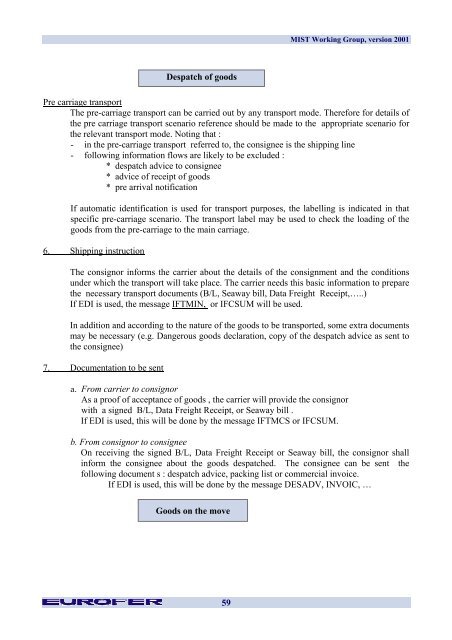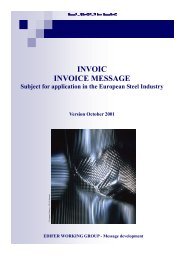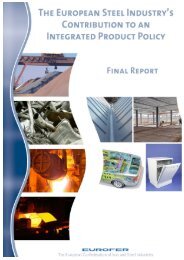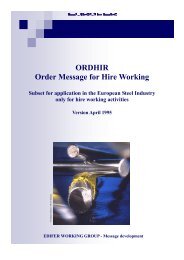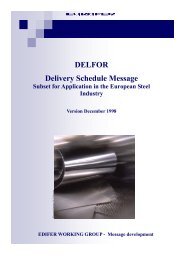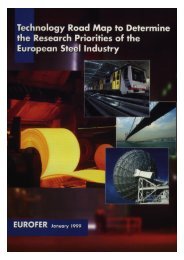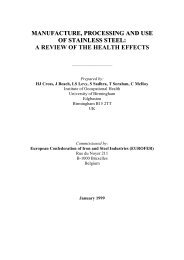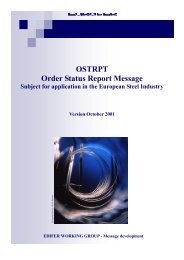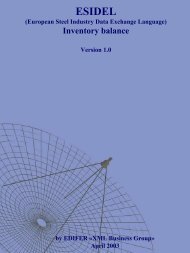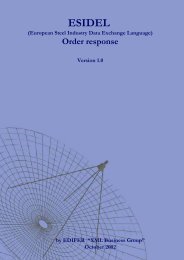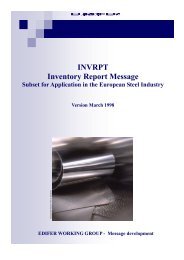Multi Industry Scenarios for Transport - Eurofer
Multi Industry Scenarios for Transport - Eurofer
Multi Industry Scenarios for Transport - Eurofer
You also want an ePaper? Increase the reach of your titles
YUMPU automatically turns print PDFs into web optimized ePapers that Google loves.
59<br />
MIST Working Group, version 2001<br />
Pre carriage transport<br />
The pre-carriage transport can be carried out by any transport mode. There<strong>for</strong>e <strong>for</strong> details of<br />
the pre carriage transport scenario reference should be made to the appropriate scenario <strong>for</strong><br />
the relevant transport mode. Noting that :<br />
- in the pre-carriage transport referred to, the consignee is the shipping line<br />
- following in<strong>for</strong>mation flows are likely to be excluded :<br />
* despatch advice to consignee<br />
* advice of receipt of goods<br />
* pre arrival notification<br />
If automatic identification is used <strong>for</strong> transport purposes, the labelling is indicated in that<br />
specific pre-carriage scenario. The transport label may be used to check the loading of the<br />
goods from the pre-carriage to the main carriage.<br />
6. Shipping instruction<br />
The consignor in<strong>for</strong>ms the carrier about the details of the consignment and the conditions<br />
under which the transport will take place. The carrier needs this basic in<strong>for</strong>mation to prepare<br />
the necessary transport documents (B/L, Seaway bill, Data Freight Receipt,…..)<br />
If EDI is used, the message IFTMIN, or IFCSUM will be used.<br />
In addition and according to the nature of the goods to be transported, some extra documents<br />
may be necessary (e.g. Dangerous goods declaration, copy of the despatch advice as sent to<br />
the consignee)<br />
7. Documentation to be sent<br />
Despatch of goods<br />
a. From carrier to consignor<br />
As a proof of acceptance of goods , the carrier will provide the consignor<br />
with a signed B/L, Data Freight Receipt, or Seaway bill .<br />
If EDI is used, this will be done by the message IFTMCS or IFCSUM.<br />
b. From consignor to consignee<br />
On receiving the signed B/L, Data Freight Receipt or Seaway bill, the consignor shall<br />
in<strong>for</strong>m the consignee about the goods despatched. The consignee can be sent the<br />
following document s : despatch advice, packing list or commercial invoice.<br />
If EDI is used, this will be done by the message DESADV, INVOIC, …<br />
Goods on the move


